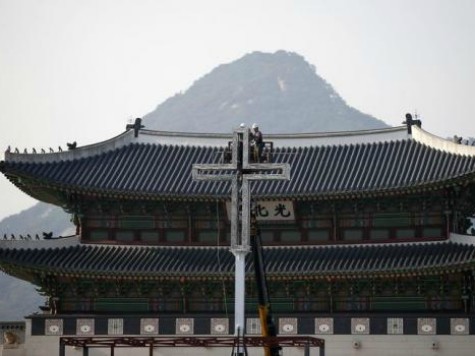Wednesday, Pope Francis departed from Rome for Seoul, South Korea, on his first visit to Asia – and Protestants have already rallied in opposition.
According to a report in the Wall Street Journal, about 10,000 people attended an event Tuesday at a convention center near Seoul led by Protestant pastors. They included leader Rev. Song Chun-Gil, who is said to have called “Catholicism a perversion of faith.” He has also resisted efforts by mainstream Protestant leaders to form closer ties with Catholics.
Evangelical Protestant communities have had large political influence in South Korea, but that has declined in recent years due to internal struggles over power and money. Protestants make up about 18.3 percent of the population (as of 2005) and recent census data shows Catholics at about 10.8 percent. The largest group claiming another specific faith is Buddhist, at 23 percent.
Catholic leaders in South Korea invited North Korea’s government-run Korean Catholic Association to attend a papal Mass scheduled for Aug. 18 at Myeong-dong Cathedral, seat of the Archdiocese of Seoul. It declined, citing South Korea’s refusal to cancel an upcoming military drill with U.S. forces, saying in a letter, “Under these circumstances, coming to Seoul would be an agonizing step.”
The Catholic presence is growing in South Korea, from less than a million in the early ’70s to over 5 million -with such recent converts as 32-year-old pop star Rain and figure skater Yuna Kim – and the Church is a respected institution in the country.
The Church currently funds 40 hospitals, 277 orphanages and day-care centers, and more than 500 centers for the elderly and disabled and has provided humanitarian relief to North Korea.
The South Korean government has welcomed the papal visit, which officially begins Thursday morning, Aug. 14, with a private Mass at the Apostolic Nunciature in Rome. Click here for the full schedule, much of which will be available via streaming Vatican video, along with being carried live and in repeats on Catholic TV and radio network EWTN.
Other events include a Mass on Friday at the World Cup Stadium in Daejeon to mark the Solemnity of the Assumption of the Blessed Virgin Mary, a lunch and a meeting with Asian youth, a visit to the Shrine of the Martyrs of Seo So mun, and a Mass for the Beatification of Paul Yun Ji-chung and 123 martyr companions at Gwanghwamun Gate in Seoul.
This ceremony marks the unusual start of Catholicism in Korea, which began not with clerical missionaries but with lay people. In 1784, scholar Ni-seung-houn, inspired by Christian books obtained by Jesuits in China through Korea’s embassy to the Chinese capital, went to Beijing to study Catholicism and was baptized Peter Ri. Upon his return, he baptized further converts.
In 1791, when the ruling dynasty, which based its society on Confucianism, considered Catholics a threat, two of Peter Ri’s converts were murdered. Yet the faith endured, with lay worship in small groups and homes, so that when Father James Tsiou arrived secretly from China three years later, he found 4,000 Catholics waiting for him.
Korean authorities killed Father Tsiou in 1801. Thirty years later, the Prefecture of the Apostolic of Korea was established by Pope Leo XII, who had received a letter smuggled out of the country by faithful Catholics. European priests began to arrive, but in 1839, a wave of persecutions and martyrdoms for the faith began, claiming the first native Korean priest, Father Andrew Kim Taegon, in 1846.
In his last letter before his death, Father Taegon concluded, “We are twenty here, and thanks be to God all are still well. If anyone is killed, I beg you not to forget his family. I have many more things to say, but how can I express them with pen and paper? I make an end to this letter. Since we are now close to the struggle, I pray you to walk in faith, so that when you have finally entered into Heaven, we may greet one another. I leave you my kiss of love.”
Altogether, persecution claimed more than 10,000 martyrs in Korea, with 79 being beatified in 1925.
In 1984, in Seoul (not in Rome, which would be the normal process), Pope John Paul II canonized the Korean martyrs of 1839, 1846 and 1867. Their feast day is on Sept. 20.
In addition, Catholic nuns and priests led many of the protests against the South Korean dictatorship from 1961 to 1987, and a bishop was among those jailed.
But as in many nations, despite improved Catholic numbers, Mass attendance is in decline, especially among the young, so the Vatican hopes that Pope Francis’ visit, especially targeted at Korean youth, will revive a fervor for the Faith.

COMMENTS
Please let us know if you're having issues with commenting.